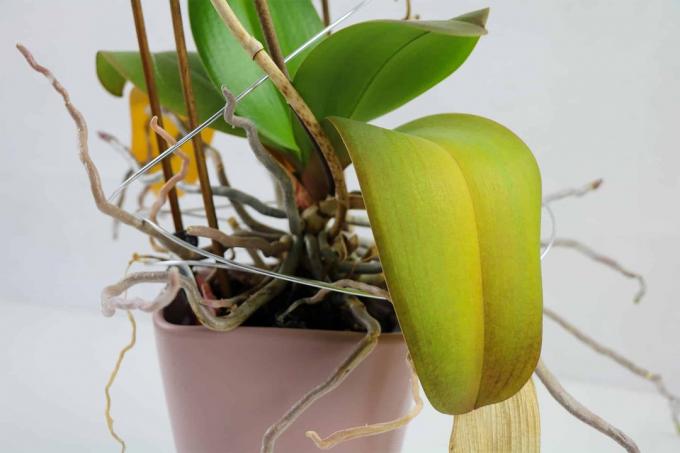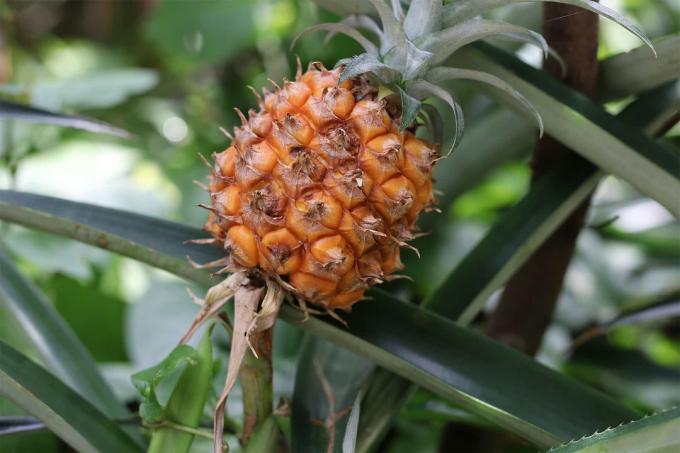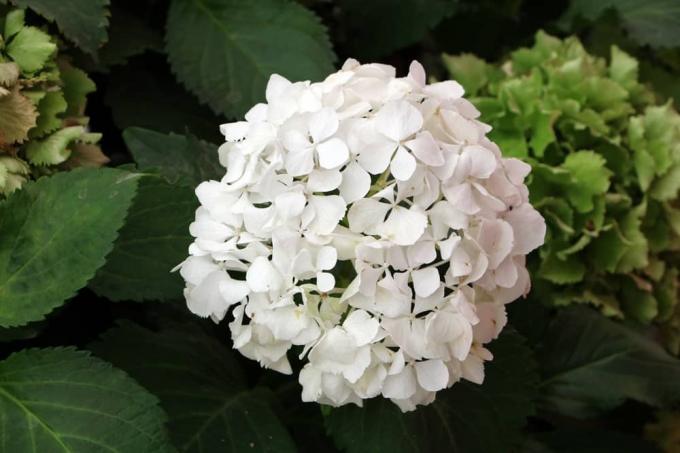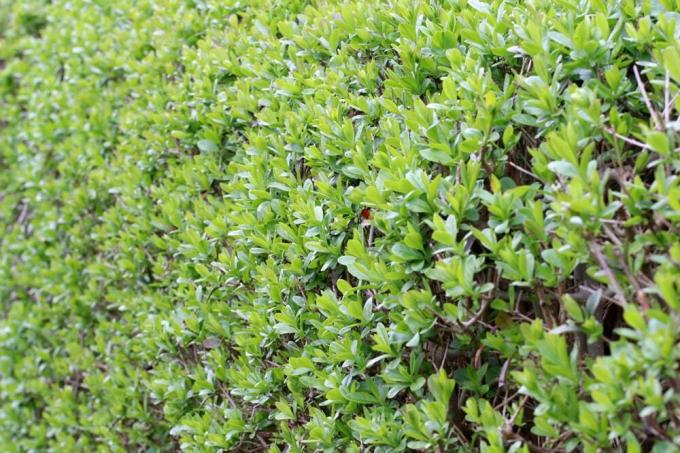

Table of contents
- Spray houseplants with water
- Spray garden plants
- Biological sprays for indoor and garden plants
- neem oil
- use
- nettle manure
- attachment
- use
- Nettle cold water extract
- use
- Oak leaf cold water extract
- use
- Canadian goldenrod tea (Solidago canadensis)
- use
- field horsetail broth
- use
- dandelion tea
- use
- compost tea
- use
- Conclusion
Indoor plants are often infested with mites when the room air is too dry, especially in the winter months when there is too much warm heating air. Most of the time, one bowl of water is more than enough for the quick humidification of the air, and you need to spray the plants with water to prevent or get rid of the mites. But garden plants are also sprayed if they have been attacked by pests or fungi. There are also preventive spraying measures with biological agents that you can make yourself.
Spray houseplants with water
Houseplants need special and frequent attention, especially in winter. Heating air that is too dry makes things difficult for them. Their leaves dry out faster and easier and their resistance decreases. Of course, pests such as mites or mealybugs have an easy time of it. To keep your indoor plants healthy and not attacked by these insects is enormous important that you dust off the leaves of the plants and then wash them with lime-free water spray. A commercially available spray bottle, which can be bought in any garden store, is ideal for this. The water temperature must not be too low, but also not too warm. The water should be at a comfortable temperature. Place foil or newspaper under the plant pots so that the subsoil does not get wet.
Do not spray in direct sunlight!
Do not spray your houseplants in direct sunlight, especially the plants on the windowsills, to avoid sunburn. It is better if you spray the plants either in the early morning hours or in the evening.
Tip:
Don't get too close to the plants when spraying, rather produce a fine mist over them. Alternatively, hard-leaved plants can also be showered off in the bathtub.
Spray garden plants
Many garden plants such as roses, perennials, ornamental and berry bushes and fruit trees are sprayed with plant strengtheners in spring, before their flowers or fruit set. In technical terms, this is called shoot spraying. This spray protects the plants from pests and diseases and at the same time strengthens them for strong growth and good fruit set. It is sprayed with commercially available or self-prepared plant strengthening preparations, which depending on proteins, Whey, potash, algae extracts, essential oils, plant hormones, chalk or rock flour can.
Tip:
Garden plants should also not be sprayed when the sun is shining, otherwise their leaves will burn. Here it is also advisable to spray in the early morning hours or in the evening.
Never spray flowers!
Whether you are spraying indoor or garden plants, skip the flowers and spray only the foliage. Otherwise the flowers will become blotchy and can quickly rot.
Biological sprays for indoor and garden plants
There are many means and options for spraying plants biologically:
neem oil
Neem oil, for example, is commercially available together with a vegetable emulsifier, so that you only have to dilute the prepared mixture with water to obtain a ready-to-spray solution receive. The concentration always depends on which plants you are spraying. Many hard-leaved house and garden plants tolerate a 1% solution. However, soft-leaved plants should only be sprayed with a 0.5% solution.
use
Neem oil reactivates the self-healing powers of the plants and is an environmentally friendly remedy against harmful insects such as aphids, spider mites, mealybugs and others. Leaves acquire a healthy shine.
nettle manure
The nettle manure is prepared in a vessel made of earthenware, wood or plastic can, but must never be made of metal to avoid unwanted reactions during the fermentation process avoid.

attachment
- 10 kg fresh nettles (cut before or during flowering) - alternatively 0.5 to 1 kg dried herb
- Let the nettle herb wilt briefly and chop
- Add 50 liters of water (preferably rainwater).
- Cover jar with grid
- stir once a day
- Add a handful of stone flour to counter unpleasant odours
- Manure finished when it stops foaming
- depending on the weather after approx. 2 to 3 weeks
As soon as the manure is ready, it is diluted with water, at least in a ratio of 1:10.
use
Nettle manure provides mainly nitrogen and can strengthen and promote growth on almost all Plants mainly flowers, fruits and vegetables are sprayed, except on garlic, onions, and beans Peas. Spraying after flowering increases the yield of fruit trees and berry plants. The smell of the diluted nettle manure keeps lice and spider mites away.
Tip:
Since nettle is ferrous, its manure can be sprayed on plants with chlorosis. For this purpose, it is sprayed on the shoots before the buds break out.
Nettle cold water extract
- is applied like stinging nettle manure
- 1 kg stinging nettles (preferably fresh) in 5 l water
- only leave for a maximum of 24 hours
- must not ferment
- applicable undiluted
use
In addition to being used as a foliar fertilizer, the nettle cold water extract is excellent against initial aphid infestation.
Oak leaf cold water extract
For this extract, the oak leaves that fall in autumn and some bark are used and mixed. The mixture should be approx. weigh 1 kg. Mix the leaves and bark with 10 liters of water and leave to stand for 12 to 24 hours. The approach must not ferment. Then dilute to 1:5 to 1:10.
use
The oak leaf cold water extract is used especially in the greenhouse against fungal infestation and sucking insects. Always spray cucumber leaves carefully as they are very large and thin!
Canadian goldenrod tea (Solidago canadensis)
Pour boiling water over a handful of goldenrod herb and leave for an hour.
use
Goldenrod tea is used preventively against downy and powdery mildew. It is also said to help against blight on tomatoes and potatoes. Spray on the plants at least once a week.
field horsetail broth
- 1 kg fresh (or 159 g dried)
- Top up with 10 liters of water
- Leave for 24 hours
If you don't have such large quantities of field horsetail in stock or don't want to use so much, you can also use 15 g Add dried herb (e.g. horsetail tea from the pharmacy) to 1 liter of water and leave to stand for 24 hours permit. The brew is then boiled on a low flame for approx. simmered for 30 minutes. The liquid then has to cool down and is only diluted 1:5 when it has cooled down.
use
Field horsetail contains a lot of silicic acid, which mainly helps against fungal diseases such as downy and powdery mildew, late blight, scab and gray mold. It is also used preventively against mites and to combat them.
dandelion tea
For dandelion tea you need 150 g of dandelion leaves in 1 liter of boiling water.
use
Spray cool and undiluted on the plants, preferably in spring. This regulates their growth. Above all, the fruit quality of fruit and berry bushes is improved.
compost tea
For compost tea, half a bucket of fresh compost is infused with rainwater. Then 3 spoonfuls of rock flour and some sugar (approx. 5g per liter) added. Mix everything well and put the bucket in a warm place with a temperature of 20 to 25 °C. Stir well twice a day. The tea is strained after a week and diluted 1:10 with rainwater.
use
The compost tea helps against powdery mildew, potato late blight, brown rot and gray mold. The plants are sprayed once a week until dripping wet.
Conclusion
Plant care also includes ensuring that the plant environment in the house has an appropriate level of humidity. This wish of the plants can easily be fulfilled with water that is regularly sprayed on their leaves. Diluted plant strengtheners can also be sprayed on, which also act against pests, especially perennials, roses, vegetables and fruit plants. However, you should not spray on felty leaves and flowers.
 garden editorial
garden editorial I write about everything that interests me in my garden.
Learn more about caring for plants

Plant hangs leaves despite water
If plants let their leaves hang despite water, this can have various causes. In order to prevent it from dying off by taking rapid countermeasures, you should find out about the possible causes and effective countermeasures here.

Plants hang their heads: what to do?
If the ornamental plants are cultivated in the garden or in pots and suddenly let their heads droop, then the question quickly arises as to why this can be. However, this is usually due to maintenance errors that need to be checked. If a remedy is found, most plants usually recover quickly.

Repot orchids: how & when to replant
Thanks to more uncomplicated and easy-care new breeds, orchids are now at home on many windowsills. In particular, the Phalaenopsis or butterfly orchid, which is available in countless varieties, is very popular. Read how and when you can best repot the distinctive beauties.

pull tree out of core | 7 tips for growing a tree yourself
Trees can be grown from cores without much effort. There are a variety of plants that have seeds and can be easily cultivated in your own garden. Special classic fruit trees should be mentioned, which are suitable for such a project.

How do hydrangeas stay white? | That way it won't turn pink
How do hydrangeas stay white - this is the question many hobby gardeners ask themselves when the hydrangea changes color. The white often turns into a pink, which is usually comparatively pale or can appear "dirty". Here we reveal how it works.

Cutting privet: when is the best time?
Privet is becoming increasingly popular and is often used as a privacy screen in the form of a privet hedge. This is not surprising, because the plant is easy to care for and fast-growing. However, it is crucial to cut the plant regularly at the right time.



